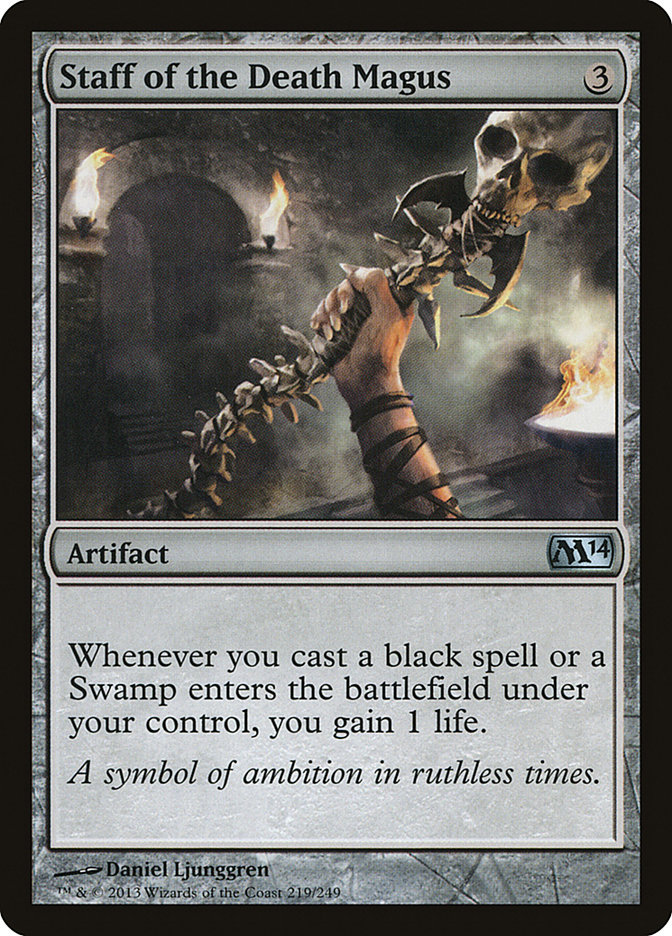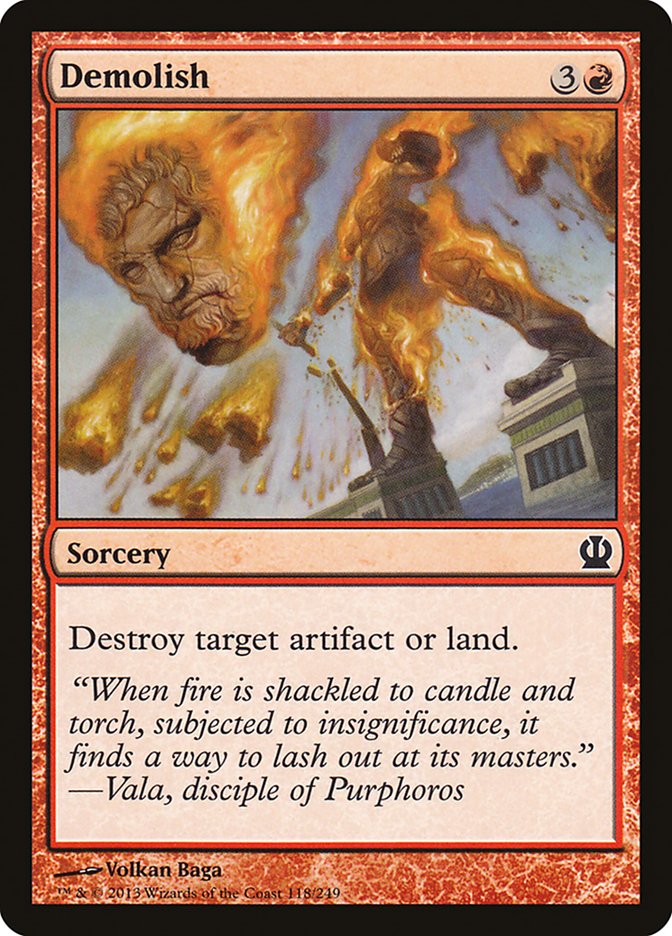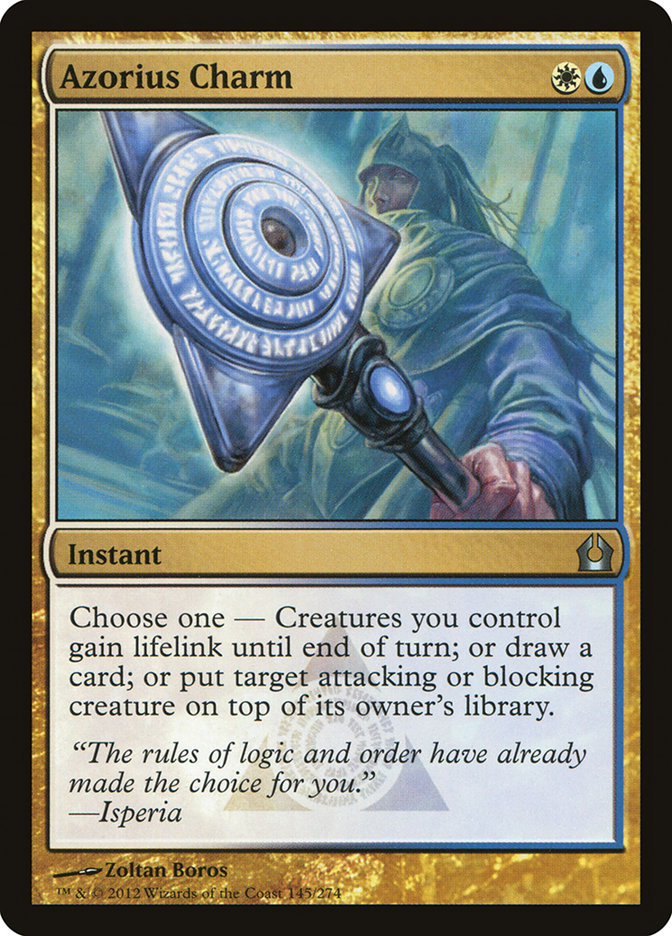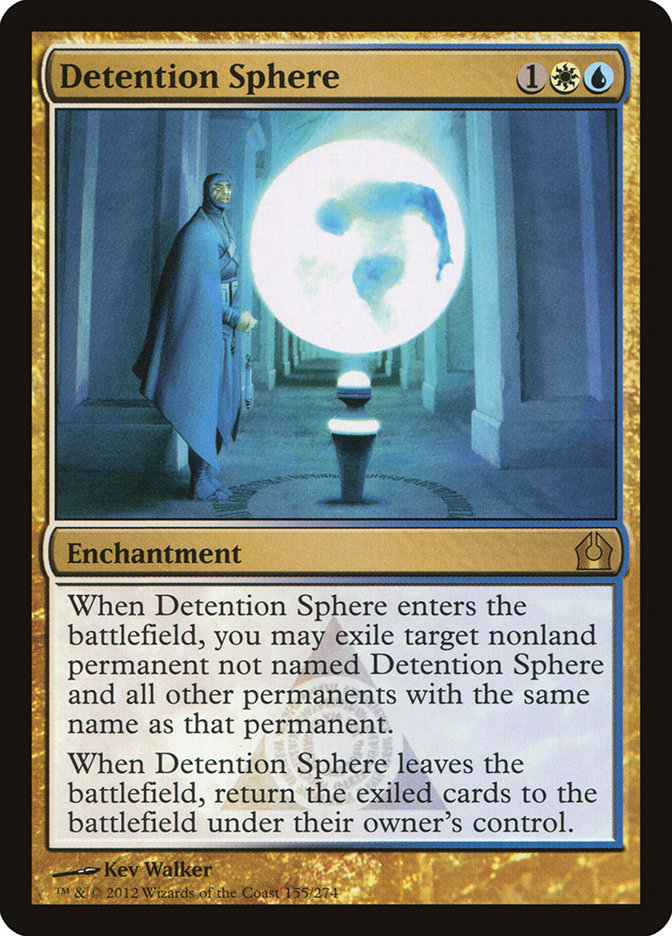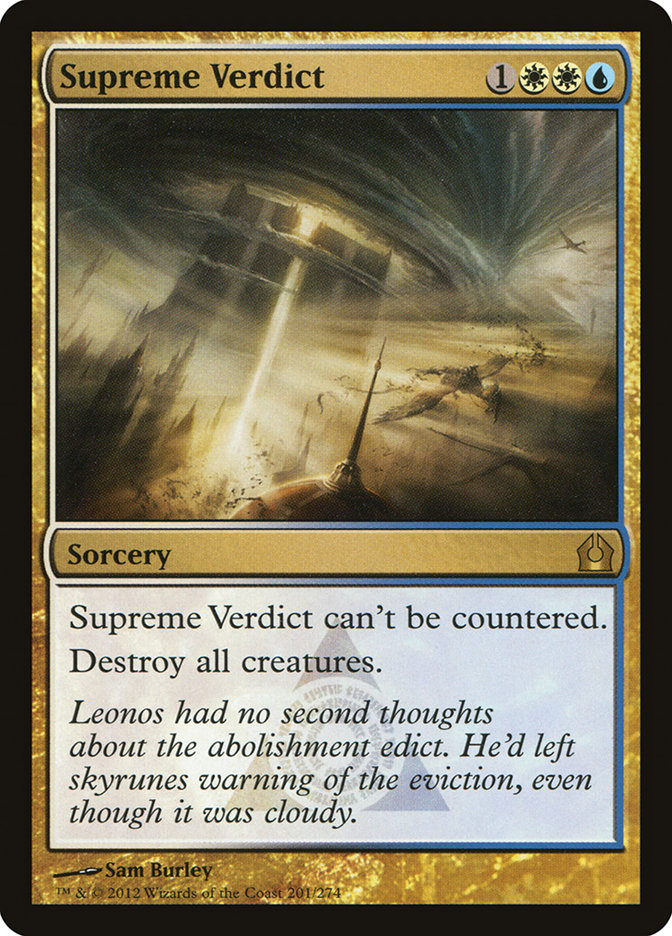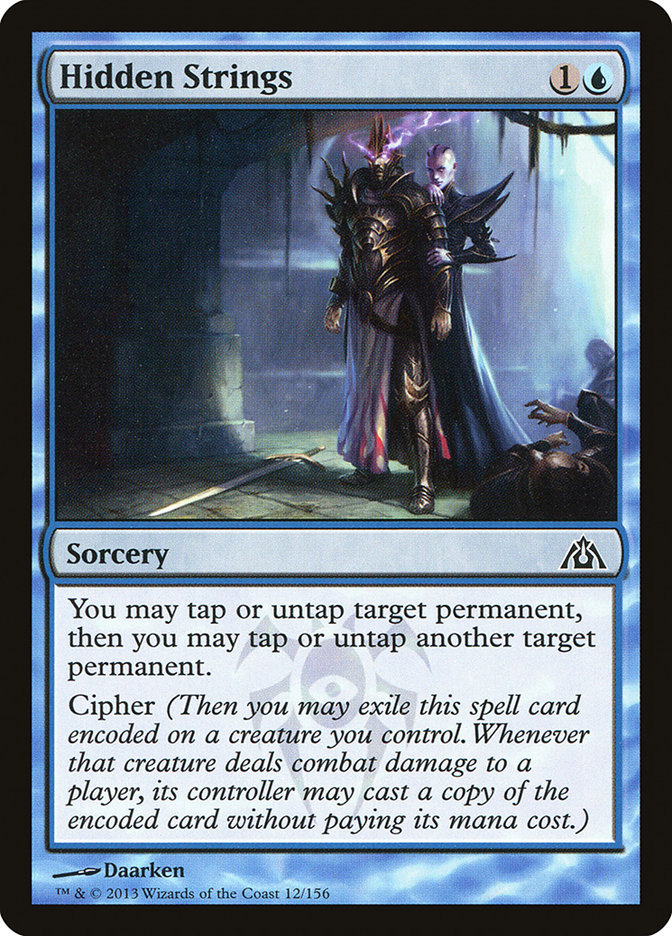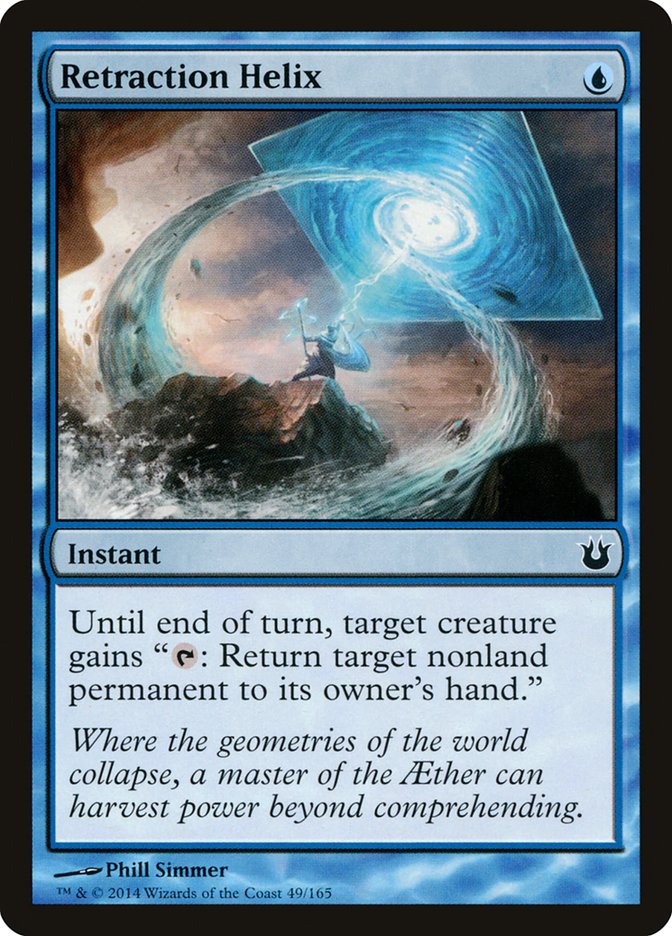Yeah, let’s just let that soak in for a minute.
. . .
. . .
. . .
So it’s come to this, eh?
I guess if you have the fortitude to register 4x Staff of the Death Magus, you deserve to win your 7th Grand Prix. Congrats @nabe1218!
— Aaron Forsythe (@mtgaaron) March 30, 2014
This past weekend Yuuya Watanabe went ahead and sleeved up the full playset of Staff of the Death Magus on his way to winning his record-tying seventh Grand Prix. Who is he tied with? Yeah, you guessed it, Kai Budde.
Of course, the amusing part is that Hall of Famer Shuhei Nakamura sleeved up a Staff of the Death Magus playset as well to try for his seventh Grand Prix win. I guess only one player can actually win any given tournament, but they did serve Shuhei well, propelling him to his 20th Grand Prix Top 8.
That’s the easy one.
"There’s quite a lot of burn decks being played on Magic Online, and that matchup is razor close every time . . . If you are concerned with the matchup and willing to make a radical change to shore it up, I suggest cutting the playset of Temple of Deceit for four Swamps and jamming two or three copies of Staff of the Death Magus in your sideboard. I don’t think the burn decks can ever beat that card." –Owen Turtenwald last week
Yuuya and Shuhei tried the Staff, and it exceeded their expectations by so much that they didn’t even need to cut all of the Temples (each shaving one or two) and went with the full four Staffs. And it ended up being the perfect call, with R/W Burn being the second biggest deck at Grand Prix Beijing, including three copies in the Top 8.
This is Yuuya’s list:
Creatures (16)
Lands (25)
Spells (19)
- 1 Duress
- 4 Thoughtseize
- 4 Underworld Connections
- 1 Ultimate Price
- 4 Devour Flesh
- 4 Hero's Downfall
- 1 Bile Blight
Sideboard

I love the use of two Read the Bones and two Erebos, God of the Dead in addition to the four Underworld Connections and eight discard spells. The Mono-Black Devotion mirror is so heavily about card advantage, and everyone having eight one-cost discard spells means we need redundancy.
Lifebane Zombie versus Nightveil Specter is a debate that has gone back and forth many times, but I share Yuuya’s desire to get an edge against Jund Monsters, white aggro, and Blood Baron of Vizkopa. Besides, Nightveil Specter is just a little too easy to kill these days.
With just a single Bile Blight maindeck (with a second in the board), Yuuya’s list is not the most anti Pack Rat, but most of his opponents didn’t know that in the tournament.
I fully expect Staff of the Death Magus to become the industry standard and lead to a decline in R/W Burn. Burn occupies the large portion of the field it does largely because of its strength against midrange and control decks. Gray Merchant of Asphodel has always made the Mono-Black matchup closer than B/W Midrange or Esper Control, but Staff of the Death Magus absolutely demolishes Burn, letting Mono-Black gain at least one life every turn (and effectively making Underworld Connections "free" by gaining an extra life off of the extra card each turn).
Staff of the Death Magus is going to sweep the field like a tidal wave, obliterating every burn deck caught in its wake unless they adapt. The solution?
R/W Burn cannot ignore this development. Staff of the Death Magus is just too effective to try to power through it. The question then becomes which artifact removal to use. Each of these three options has applications.
Wear // Tear is the cheapest and most efficient solution. It’s my initial favorite since it has a super low cost, is flexible, and is capable of the absolutely backbreaking play of hitting both Staff of the Death Magus and Underworld Connections at the same time!
The only real problem with Wear // Tear is its vulnerability to Duress and Thoughtseize. Reckless Reveler’s strength is then revealed, as you can play it proactively on turn 2 and start beating down with it. Of course, the problem with Reckless Reveler is that trading with one of your opponent’s removal spells is not a great use of a sideboard slot in this matchup. If you wait to cast it when they have the Staff, you risk it getting Thoughtseized (though at least it dodges Duress).
Demolish is mostly a worse Wear // Tear, but it can hit the land Underworld Connections is on, not to mention having flexibility against Mutavault or as a possible anti-control card. Overall, though, I think the flexibility and efficiency of Wear // Tear makes it the superior of these three options. Revoke Existence is also an option, perhaps as a one-of to complement another plan. If you wanted it for the Mono-Blue Devotion matchup anyway, it would totally come in against black now.
I wonder if Staff of the Mind Magus is going to see any play now . . .
Mono-Blue Devotion is so much less in need of the life gain and without removal can actually lose to R/W Burn’s few creatures (unlike Mono-Black Devotion). My guess is that they don’t want it, but it is an interesting option to try.
For reference, here is a burn deck from this weekend, which should be the second deck in any playtest gauntlet this week:
Creatures (4)
Lands (18)
Spells (38)

While most burn decks are just straight R/W these days, Sherwin returned to the deck’s roots, splashing black for Toil // Trouble while minimizing the number of creatures in his maindeck. The sideboard is a very different story however. While four copies of Firedrinker Satyr is standard operating procedure against slow decks, the playset of Satyr Firedancer is kind of hot. When facing opponents with lots of creatures and no removal (like Mono-Blue Devotion), Satyr Firedancer can completely take the game over. Boros Charm dealing four to the face and four to a creature is pretty huge, and Searing Blood killing two creatures can be devastating.
While burn was absolutely massive in China, the US metagame took a slightly different turn this week with the rise of Mono-Red Aggro. First, though, let’s take a look at the metagame as a whole to understand the differences between the US and Chinese metagames.
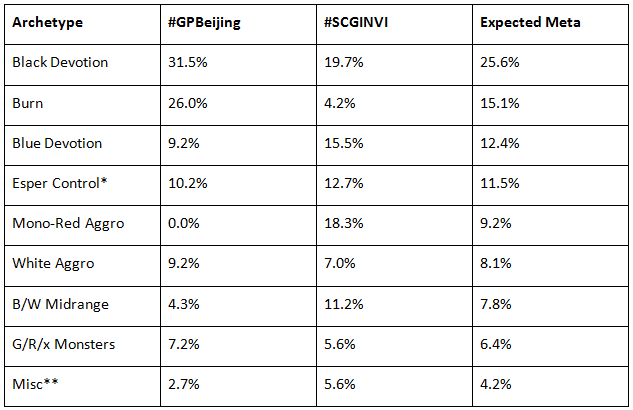
*Esper Control includes a U/W Control list and a Bant Control list
**Misc = Green Devotion, B/U Heroes, W/G Hexproof, Five-Color Ramp, and more
The #GPBeijing metagame data is half the day 2 metagame breakdown and half the Top 8 decks weighted by finish. The #SCGINVI data is actually half the decks went 7-1 or better in Standard at the Invitational and half Top 16 metagame of the SCG Standard Open in Charlotte during the same weekend. The expected metagame is the average of both of these events and serves to predict the field you’re actually going to need to beat to win the event (which is not the same as the round 1 metagame).
Once again we see the international metagame mirroring the US metagame from one or two weeks ago. The twist this time is that the discovery of Staff of the Death Magus will likely lead to an alternate timeline, of sorts and a different evolutionary track. The US metagame of today evolved in a world without Staff of the Death Magus, a world that will never exist in Beijing. This is going to increase the volatility of the metagame this week. Which metagame is closer to the one we’ll see next week?
Maybe neither!
Depending on how well the red decks are able to adapt, we may see a pretty big shakeup in the format this week. The other big X factor is what happens when the recent wave of Mono-Red Aggro decks in the US crashes into the Staff of the Death Magus movement coming from the Far East.
Creatures (29)
Spells (31)
Sideboard

Creatures (28)
- 4 Chandra's Phoenix
- 4 Gore-House Chainwalker
- 4 Rakdos Cackler
- 4 Burning-Tree Emissary
- 4 Firefist Striker
- 4 Foundry Street Denizen
- 4 Firedrinker Satyr
Lands (4)
Spells (28)

With creature decks on the decline, many US players have turned to Mono-Red Aggro. This strategy is somewhat similar in high-level vision to R/W Burn; however, it isn’t appropriate to merge these decks into a single archetype. R/W Burn has very few creatures at all, relying on burn and planeswalkers to damage people. The Mono-Red Aggro deck is the exact opposite with very few burn spells at all, and the burn spells it does have are primarily for clearing a path for its attackers.
Just look how few creatures these lists have in common with the burn deck! Not all of the same cards are going to be good against both decks. For instance, what you really want to beat this deck with black is access to a Drown in Sorrow or two if you can afford the space.
I would guess you still want Staff of the Death Magus against this style of deck, but it is far less effective. Red aggro has tons of creatures capable of hitting for a lot more than one a turn, meaning life gain in general is less devastating. Additionally, this strategy is much faster than R/W Burn, giving you less time to reap the benefits of the Staff. Interestingly, Reckless Reveler could be added to Mono-Red Aggro’s maindeck relatively easily. It’s not like you actually want all these Gore-House Chainwalkers.
While straight Mono-Red Aggro was the breakout deck of the weekend, Tom Ross had people talking about the R/G variant that he took to a Top 8 finish in the Invitational:
Creatures (27)
- 2 Ash Zealot
- 4 Rakdos Cackler
- 4 Burning-Tree Emissary
- 4 Ghor-Clan Rampager
- 2 Legion Loyalist
- 4 Skylasher
- 3 Firedrinker Satyr
- 4 Fanatic of Xenagos
Lands (21)
Spells (12)
Sideboard

While this is certainly a red deck with green in it, it is more than just a light splash.
- 4 Skylasher in the maindeck
- 4 Fanatic of Xenagos in the maindeck
- 4 Ghor-Clan Rampager in the maindeck
- 2 Armed // Dangerous in the maindeck, 1 in the sideboard
- 3 Domri Rade in the sideboard
Ghor-Clan Rampager helps Ross get away with less burn than most would play, while Skylasher and Fanatic of Xenagos contribute to a pseudo-haste game plan that lets him play a different pace than other red decks. Madcap Skills especially appreciates having a durable threat like Skylasher to enhance.
Ross’ list has almost nothing in common with the burn deck, and in trying to merge similar strategies to get a macro view of the format, it would seem that Lightning Strike is basically the only universal red card (outside of lands because let’s be serious, everyone plays Mutavault). However, basically every other red deck uses Chandra’s Phoenix, and it is much more of a pillar of red decks, so it gets the nod below. For reference, here is a big picture view of last weekend’s metagame:
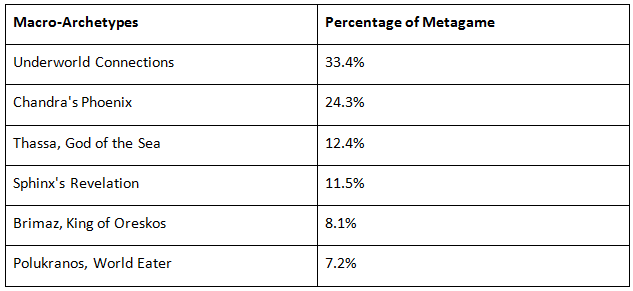
In this chart, Lightning Strike is a little bit of a cheat, as the rest of the decks are labeled by their heavy-hitting franchise player. The red decks most often rely on Chandra’s Phoenix, though depending on the type of red deck, Stormbreath Dragon or Burning-Tree Emissary are both reasonable pillars.
Polukranos, World Eater is perhaps a questionable pillar since Domri Rade might be deserving of the title, particularly when you add in the other fringe Domri Rade decks like R/G Aggro and Naya Midrange.
Interestingly, this adds up to one for each color plus a single gold pillar. It really does seem like Standard is currently a format where you pick one of the six colors to be your primary color and one to be your support if you want.
Six colors?
Yeah, of course, the six colors of Magic:
- White
- Blue
- Black
- Red
- Green
- Azorius
I wonder why Azorius gets such special treatment . . .
On the whole, this wasn’t a great weekend for Esper Control. Esper completely crushed the format last week, so not surprisingly everyone and their mother slanted their lists against control. While Staff of the Death Magus doesn’t directly help Esper, it may prove somewhat beneficial in that it will contribute to a decrease in R/W Burn decks (which are a little problematic for Esper).
The problem of course is that this may also bring with it more Mono-Black Devotion, which is not what Esper wants to face. This is particularly true now that black decks are playing the eight discard spells and eight black card drawers like Yuuya from above.
What I wonder is what the advent of Staff of the Death Magus means for the black decks with splash colors. While it doesn’t trigger off of Temple of Silence or Orzhov Guildgate, is it possible that Staff of the Death Magus is just so effective that B/W wants a couple?
Creatures (15)
Planeswalkers (1)
Lands (23)
Spells (21)

Yes, this is six less Swamps to trigger Staff of the Death Magus, but when every single spell short of Elspeth, Sun’s Champion triggers it, that isn’t really that big of a drop. Besides, you generally want to lead with Temple of Silence and Orzhov Guildgate anyway, saving your Swamps for turns 4, 5, or 6.
What about B/R Devotion, like the list Eric Froehlich took to a Top 16 finish at GP Cincinnati last weekend?
Creatures (13)
Lands (26)
Spells (21)

Here Staff of the Death Magus is just a total slam dunk. We’ve got just two less Swamps than Yuuya, and literally a hundred percent of the spells in the deck are black. Without Blood Baron of Vizkopa or Obzedat, Ghost Council, we need the life gain more than B/w does. It’s not surprising to see B/R want the Staff, either, as it is very nearly just Mono-Black with Rakdos’s Return.
While Mono-Blue Devotion had basically fallen off the map in the US over the past few weeks, it was back with a vengeance this week. The secret to its success? The same secret that always determines Mono-Blue Devotion’s success:
Did Esper Control have a good week?
If yes, Mono-Blue Devotion is going to have problems. If no, it’s time for another Thassa, God of the Sea comeback!
The printing of Ephara, God of Polis has opened up the archetype to a little more diversity than existed prior to Born of the Gods. While the world solved the question of what the best Mono-Blue Devotion deck looked like within a few weeks of Pro Tour Theros, it appears the debate between Mono-Blue and U/W is tougher to resolve.
Creatures (28)
- 4 Judge's Familiar
- 4 Frostburn Weird
- 2 Cloudfin Raptor
- 4 Nightveil Specter
- 4 Tidebinder Mage
- 4 Thassa, God of the Sea
- 4 Master of Waves
- 2 Ephara, God of the Polis
Planeswalkers (1)
Lands (14)
Spells (17)

Contrast this with Sam Black’s list, featuring stone zero Born of the Gods cards:
Creatures (28)
- 4 Judge's Familiar
- 4 Frostburn Weird
- 4 Cloudfin Raptor
- 4 Nightveil Specter
- 4 Tidebinder Mage
- 4 Thassa, God of the Sea
- 4 Master of Waves
Planeswalkers (1)
Lands (5)
Spells (26)
Sideboard

Regular readers probably noticed a huge drop-off in Jund Monsters compared to a couple weeks ago. What happened? Shouldn’t there be more Jund given how well Esper Control did last week (with Jund having edge in that matchup)?
It’s basically the same situation as with Mono-Blue Devotion but in reverse. When Esper Control thrives, Jund Monsters does well, and Mono-Blue Devotion does not. Since Esper got attacked hard this week, Mono-Blue surged while Jund suffered.
Another beneficiary of the decline of Supreme Verdict was white-based aggro. It’s not that white aggro decks lose to Verdicts per se, but the card is quite good against them and often accompanies Sphinx’s Revelation, which thrashes them.
While white aggro decks are most often W/B, W/R, or W/G, this weekend did include another big finish by Esper Midrange:
Creatures (24)
- 1 Pack Rat
- 4 Lyev Skyknight
- 4 Precinct Captain
- 1 Keening Apparition
- 3 Obzedat, Ghost Council
- 1 Imposing Sovereign
- 4 Soldier of the Pantheon
- 2 Ephara, God of the Polis
- 4 Brimaz, King of Oreskos
Lands (22)
Spells (14)

This deck really is just a bunch of good cards that you throw at the opponent and see what sticks. It sure is fun though!
The more common white aggro deck is W/B Humans, actually utilizing the Human tribe thanks to Xathrid Necromancer. This build has been steadily gaining popularity over the past month, with Pain Seer becoming the industry standard (and actually living up to the hype).
Creatures (28)
- 4 Dryad Militant
- 3 Daring Skyjek
- 3 Banisher Priest
- 3 Imposing Sovereign
- 4 Xathrid Necromancer
- 4 Soldier of the Pantheon
- 4 Pain Seer
- 3 Spirit of the Labyrinth
Lands (16)
Spells (16)

Okay, we’re just about out of time today; however, I do want to make sure to touch on this weekend’s coolest new deck. While Tom Ross gets the innovation prize Stateside, I gotta give it to Ken Yukuhiro over in Beijing. Take a look at B/U Heroes!
Creatures (21)
- 2 Nivmagus Elemental
- 4 Xathrid Necromancer
- 3 Artisan of Forms
- 4 Tormented Hero
- 4 Agent of the Fates
- 4 Pain Seer
Lands (16)
Spells (23)
- 4 Island
- 2 Springleaf Drum
- 1 Ultimate Price
- 3 Mizzium Skin
- 4 Hidden Strings
- 3 Boon of Erebos
- 4 Triton Tactics
- 2 Retraction Helix
Sideboard

Holy cow! Agent of Fates, Artisan of Forms, and Tormented Hero mean lots of juicy targets for your targeting tricks, and Nivmagus Elemental serves as sort of a secret fourth heroic creature. Sometimes just eating a bunch of one-mana tricks is worth it, but Hidden Strings is where the real payoff comes since you can eat the extra copy every turn.
Hidden Strings is very much the engine the deck runs on, letting you switch from a grindy two-for-one game into a powerhouse that can send a game against a creature-based deck spiraling out of control. Remember, Hidden Strings effectively costs zero mana if you want since you can untap the lands you used on it. In fact, it often nets mana, letting you untap four lands (or the same two lands twice) the turn you cast it. Hidden Strings also has the hidden mondo combo with Retraction Helix that lets you bounce lots of permanents in the same turn.
The deck has a lot of somewhat dubious combat tricks, so the extra card flow from Pain Seer is particularly valuable. Additionally, Boon of Erebos, Triton Tactics, and Mizzium Skin give you tons of ways to protect him while still sending him into the red zone. Be careful with Mizzium Skin. While you will sometimes want to overload it to get the AOE effect, doing so means no heroic triggers.
In addition to just turning the Pain Seer sideways, Springleaf Drum and Retraction Helix give you extra ways to trigger it from a distance. Triton Tactics has a million abilities, including untapping creatures, which means more instant speed triggers if you want them. Last but certainly not least, Hidden Strings lets you kind of go off with Pain Seer. For instance:
Turn 1: Cast a Springleaf Drum.
Turn 2: Pain Seer and now you have ten ways to protect it with the Drum, which you can tap on your opponent’s end step producing the color of mana for a trick, letting you trigger Pain Seer an extra time without ever letting your guard down.
Turn 3: Trigger the Seer when it untaps. Then tap the Seer for a mana and cast Hidden Strings on it and the Drum, giving you another Pain Seer trigger. Attack for two, triggering Hidden Strings. Untap Pain Seer and a land, giving you yet another Pain Seer trigger. With Springleaf Drum available, you should have a total of four extra mana to use on all those new spells plus the ability to tap Pain Seer yet again!
B/U Heroes is the most unique new deck we’ve seen since Born of the Gods, and I can’t wait to take it for a spin. I’ve experimented a bit with Hidden Strings since its printing (and Sam Black’s brief infatuation with it). It would appear that Pain Seer was the most important missing link, but Retraction Helix and Springleaf Drum are valuable upgrades as well.
What I want to know is what’s next? Is B/U Heroes really the only way to build this deck? I can’t help but feel like there might be some kind of a green heroic deck out there using Warrior’s Lesson for even more going off. Pain Seer is a pretty compelling reason to play black, and Hidden Strings + Triton Tactics makes blue very attractive. The thing is that Springleaf Drum produces all five colors. I wonder if there is a three-color (or more) heroic/inspired deck out there.
This week’s new technology is going to throw a serious monkey wrench into the format. Staff of the Death Magus was pretty clearly the most underrated card in Standard. I guess the real question is:
What is the next Staff of the Death Magus?

